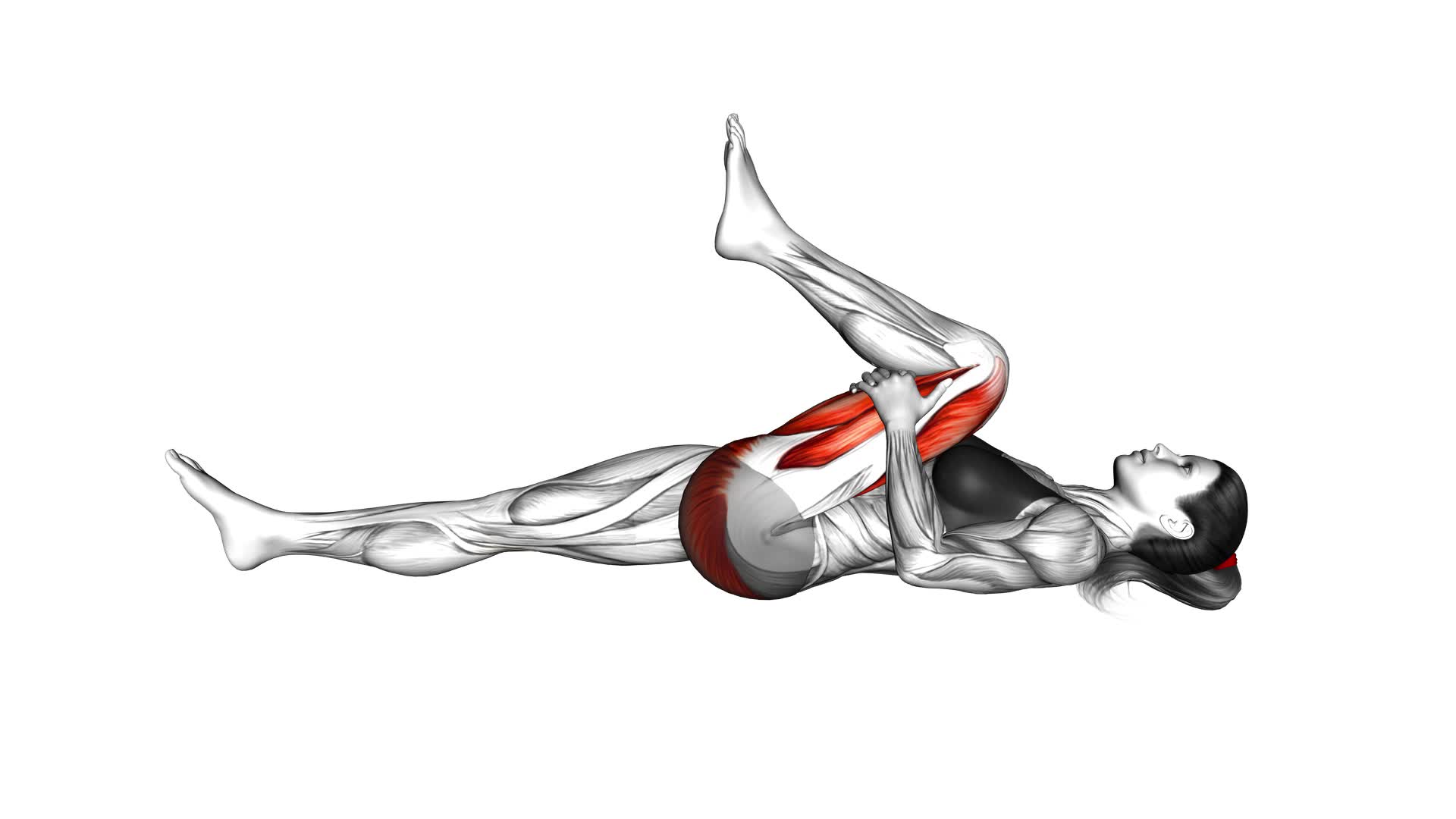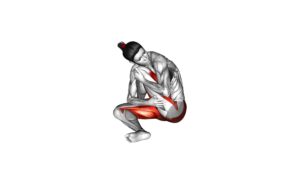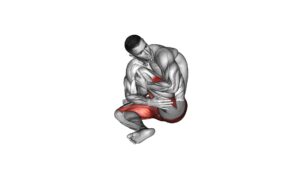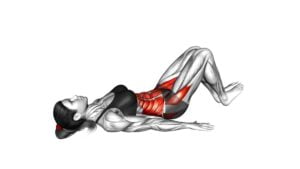Lying Knee Hug (female) – Video Exercise Guide & Tips

Are you looking for a new exercise to add to your routine? Look no further than the Lying Knee Hug!
Watch This Exercise Video
This simple yet effective exercise targets your core and lower body muscles.
In this video exercise guide, you'll learn the proper form and technique, as well as modifications for beginners and advanced variations.
Avoid common mistakes and get tips on how to incorporate the Lying Knee Hug into your workout routine.
Let's get started!
Key Takeaways
- The lying knee hug targets core and lower body muscles, toning and strengthening the hips, glutes, and thighs.
- Proper form and technique are essential, including engaging the core, avoiding arching the back or using momentum, and maintaining control and stability throughout.
- Beginners can modify the exercise by trying easier variations, hugging one knee at a time, reducing range of motion or using support, and gradually increasing difficulty.
- Advanced variations of the lying knee hug include torso rotation and leg extension, which challenge the core muscles and engage the obliques.
Benefits of the Lying Knee Hug
The lying knee hug offers numerous benefits for women looking to improve their lower body strength and flexibility. This exercise primarily targets the muscles in the hips, glutes, and thighs, making it an excellent choice for toning and strengthening these areas. By engaging these muscle groups, the lying knee hug helps to increase overall lower body strength, allowing women to perform daily activities with ease and reduce the risk of injury.
In addition to strength, the lying knee hug also promotes flexibility. As you bring your knees towards your chest and hold the position, you stretch the muscles in your hips and lower back. This stretching action helps to improve flexibility, allowing for a greater range of motion in the hips and increasing overall mobility.
To reap the full benefits of the lying knee hug, it's essential to maintain proper form. Start by lying flat on your back with your legs extended. Slowly bring one knee towards your chest, using your hands to gently pull it in closer. Hold for a few seconds, then switch to the other leg. Remember to keep your back flat on the ground throughout the movement and avoid any jerking or bouncing motions.
Incorporating the lying knee hug into your fitness routine can lead to improved lower body strength and flexibility. By performing this exercise with proper form, you can maximize the benefits and achieve your fitness goals.
Proper Form and Technique
To perform the lying knee hug exercise with proper form and technique, it's important to engage your core muscles correctly and avoid common form mistakes.
Keep your abs tight and pull your knee towards your chest, using your core strength to control the movement.
Be mindful of not arching your back or using momentum to swing your leg up, as this can compromise the effectiveness of the exercise.
Focus on maintaining control and stability throughout the movement to maximize the benefits of the lying knee hug.
Engaging Core Muscles Correctly
Engage your core muscles correctly by maintaining proper form and technique during the Lying Knee Hug exercise. Engaging your core muscles is crucial for core stability training and overall strength.
To do this exercise correctly, start by lying flat on your back with your knees bent and feet flat on the ground. As you bring one knee towards your chest, focus on contracting your abdominal muscles and drawing your belly button towards your spine. Keep your lower back pressed into the ground to ensure proper engagement of the core. Hold the position for a few seconds before returning to the starting position.
By engaging your core muscles throughout the exercise, you'll maximize its effectiveness and prevent strain on other parts of your body.
Now, let's move on to the next section about avoiding common form mistakes.
Avoiding Common Form Mistakes
To ensure proper form and technique during the Lying Knee Hug exercise, focus on maintaining a neutral spine position throughout the movement.
One common form mistake to avoid is rounding your back or arching it excessively. This can put unnecessary strain on your spine and lower back. Instead, keep your spine in a natural position by engaging your core muscles and drawing your belly button towards your spine.
Another important aspect of proper technique is to use your hip flexors to bring your knee towards your chest, rather than relying solely on your arms. This ensures that you're targeting the correct muscles and getting the most out of the exercise.
Modifications for Beginners
If you're new to the lying knee hug exercise, there are several modifications you can make to make it easier and more accessible for beginners.
One option is to try easier knee hug variations, such as bringing your knees closer to your chest or hugging one knee at a time.
Another option is to adjust the intensity by reducing the range of motion or using a support, like a yoga block or towel.
Easier Knee Hug Variations
Try incorporating these modifications to make the knee hug exercise easier for beginners.
If you find it challenging to lift both legs off the ground at the same time, start by hugging one knee towards your chest while keeping the other foot flat on the ground. This modification allows you to focus on engaging your core and strengthening your hip flexors without putting too much strain on your lower back.
Another beginner-friendly knee hug variation is to use a resistance band or a towel to assist you. Loop the band or towel around your foot and hold onto the ends while hugging your knee towards your chest. This provides added support and helps you gradually build strength and flexibility.
Remember to listen to your body and gradually increase the difficulty as you progress in your fitness journey.
Adjusting Intensity for Beginners
If you're a beginner looking to adjust the intensity of the knee hug exercise, there are a few modifications you can try.
One way to decrease the intensity is by bending your knees less when bringing them towards your chest. This will reduce the range of motion and make the exercise easier.
Another modification is to perform the knee hug exercise while lying on your back instead of on your side. This position provides more stability and support, making it more suitable for beginners.
Additionally, you can start with fewer repetitions and gradually increase the number as you build strength. These adjustments will help you gradually progress and avoid overexertion.
Now, let's move on to discussing some common modifications for beginners.
Common Beginner Modifications
To make the lying knee hug exercise easier for beginners, you can make modifications by bending your knees less and lying on your back instead of on your side. Here are some alternative options for beginners to try:
- Reduce knee bend: Instead of bringing your knees all the way to your chest, start by bending them slightly and gradually increase the range of motion as you build strength and flexibility.
- Use a pillow for support: If lying on your back feels uncomfortable, place a pillow under your head and neck for added support and to alleviate any strain.
- Perform the exercise with one leg at a time: If hugging both knees simultaneously is challenging, try hugging one knee at a time while keeping the other leg extended.
- Use a resistance band: To make the exercise easier, loop a resistance band around your thighs and hold onto it while performing the knee hug motion. This will provide assistance and make it easier to lift your legs.
Advanced Variations and Progressions
To advance your Lying Knee Hug exercise, incorporate challenging variations and progressions. These advanced modifications will help you take your core workout to the next level.
One advanced variation is the Lying Knee Hug with a Twist. Start by lying on your back with your knees bent and feet flat on the floor. As you bring one knee towards your chest, simultaneously twist your torso to the opposite side, reaching your opposite elbow towards your knee. This not only targets your core but also engages your obliques.
Another progression is the Lying Knee Hug with Leg Extension. Begin in the same position as the basic Lying Knee Hug, but as you bring one knee towards your chest, extend the opposite leg straight out. This adds an element of balance and stability, challenging your core even further.
Remember, when performing these advanced core exercises, it's important to maintain proper form and control. Start with a few reps and gradually increase as you build strength.
Incorporating these advanced variations and progressions will help you maximize the benefits of the Lying Knee Hug exercise and continue challenging your core muscles.
Common Mistakes to Avoid
One common mistake to avoid when performing the Lying Knee Hug exercise is failing to maintain proper form and control. Here are four common mistakes to watch out for:
- Allowing the lower back to arch: When performing the Lying Knee Hug, it's important to keep your lower back flat against the ground. Arching your lower back can put unnecessary strain on the spine and reduce the effectiveness of the exercise.
- Rushing through the movement: Proper form requires controlled movements. Avoid rushing through the exercise by quickly bringing your knees towards your chest and releasing them back down. Instead, focus on engaging your core and using a slow, controlled motion to maximize the benefits.
- Not fully extending the legs: In order to fully engage the muscles targeted by the Lying Knee Hug, it's important to fully extend your legs before bringing them back in. Failing to fully extend the legs can limit the range of motion and decrease the effectiveness of the exercise.
- Using momentum instead of muscles: It's common to see people swinging their legs or using momentum to perform the Lying Knee Hug. However, this takes away from the intended muscle engagement. Focus on using your core muscles to control the movement and avoid relying on momentum.
Tips for Incorporating the Lying Knee Hug Into Your Workout Routine
Incorporate the Lying Knee Hug into your workout routine for an effective lower body strengthening exercise. By incorporating knee hugs, you can maximize the benefits of this exercise and target your glutes, hips, and hamstrings.
To begin, lie flat on your back with your legs extended. Bend one knee and bring it towards your chest, hugging it with both hands. Hold the position for a few seconds, feeling the stretch in your hip and glute muscles. Slowly release and repeat on the other side.
To make the most of your knee hugs, consider these tips. First, focus on maintaining proper form throughout the exercise. Keep your core engaged and your back pressed firmly against the floor. This will help prevent any strain on your lower back.
Additionally, try to control the movement and avoid using momentum. By moving slowly and intentionally, you can engage your muscles more effectively and get the most out of each repetition.
Lastly, consider incorporating knee hugs into a larger lower body workout routine. Pair them with exercises like squats, lunges, and deadlifts to create a well-rounded lower body strengthening session.
Frequently Asked Questions
Can the Lying Knee Hug Exercise Help in Reducing Lower Back Pain?
The lying knee hug exercise can be beneficial in reducing lower back pain. By hugging your knees towards your chest while lying on your back, you can stretch and strengthen the muscles in your lower back and hips.
This exercise also helps improve flexibility and mobility in the spine. There are variations of the lying knee hug, such as adding a gentle rocking motion or holding the stretch for a longer duration, which can provide additional benefits.
How Many Sets and Reps Should Be Performed for the Lying Knee Hug Exercise?
To determine the number of sets and reps for the lying knee hug exercise, consider your fitness level and goals. Start with 2-3 sets of 10-12 reps, gradually increasing as you get stronger.
The lying knee hug exercise targets the hip flexors, glutes, and lower back. It can help improve hip mobility, strengthen core muscles, and alleviate lower back pain.
There are variations of the lying knee hug exercise that can add challenge and variety to your workout routine.
Are There Any Precautions or Contraindications for Individuals With Knee Injuries or Conditions?
When it comes to knee injuries or conditions, it's important to take precautions and be aware of any contraindications.
It's always best to consult with a healthcare professional before attempting any exercise, including the lying knee hug.
They can provide personalized guidance based on your specific situation.
Can the Lying Knee Hug Exercise Be Done Without Any Equipment?
Yes, the lying knee hug exercise can be done without any equipment. It's a simple yet effective exercise that targets the core and hip muscles.
To perform this exercise, lie on your back with your knees bent and feet flat on the ground. Then, bring one knee towards your chest, hugging it with your hands, and hold for a few seconds. Alternate between legs.
This exercise helps improve flexibility, strengthens the core, and increases hip mobility.
Is There a Recommended Warm-Up or Stretching Routine to Do Before Performing the Lying Knee Hug Exercise?
Before performing the lying knee hug exercise, it's recommended to warm up your body and do some dynamic stretches.
Preparatory exercises like jogging in place or jumping jacks can help increase your heart rate and loosen up your muscles.
Dynamic stretches, such as leg swings or hip circles, can help improve flexibility and range of motion.
These warm-up activities can help reduce the risk of injury and prepare your body for the lying knee hug exercise.
Conclusion
Incorporating the lying knee hug into your workout routine can offer numerous benefits. This exercise helps improve flexibility and mobility in the hips and lower back, while also engaging the core muscles.
By maintaining proper form and technique, you can maximize the effectiveness of this exercise. Beginners can modify the movement by using a resistance band or starting with smaller ranges of motion.
Advanced variations and progressions can be added to challenge yourself further.
Avoiding common mistakes and following these tips will ensure a successful workout experience with the lying knee hug.

Author
Years ago, the spark of my life’s passion ignited in my mind the moment I stepped into the local gym for the first time. The inaugural bead of perspiration, the initial endeavor, the very first surge of endorphins, and a sense of pride that washed over me post-workout marked the beginning of my deep-seated interest in strength sports, fitness, and sports nutrition. This very curiosity blossomed rapidly into a profound fascination, propelling me to earn a Master’s degree in Physical Education from the Academy of Physical Education in Krakow, followed by a Sports Manager diploma from the Jagiellonian University. My journey of growth led me to gain more specialized qualifications, such as being a certified personal trainer with a focus on sports dietetics, a lifeguard, and an instructor for wellness and corrective gymnastics. Theoretical knowledge paired seamlessly with practical experience, reinforcing my belief that the transformation of individuals under my guidance was also a reflection of my personal growth. This belief holds true even today. Each day, I strive to push the boundaries and explore new realms. These realms gently elevate me to greater heights. The unique combination of passion for my field and the continuous quest for growth fuels my drive to break new ground.







